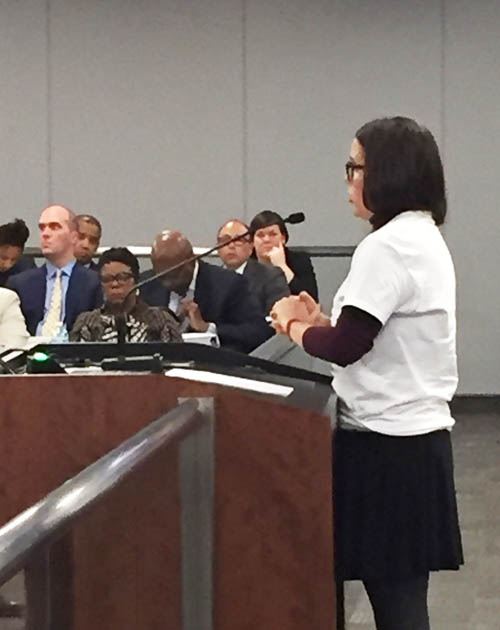BOARDWATCH: Bizarre is the best word to describe the December 7, 2016 meeting of the Chicago Board of Education... 'At one point, Forrest Claypool, showed his ignorance by stating that children can outgrow their disabilities!...'
 Substance photo by Susan Hickey.It was a bizarre Board of Education meeting December 7, 2016, on so many levels; one that I am still trying to process. The CEO’s report took up more time than usual with public participation starting at 12:45 p.m. with charter schools parents taking up more than their share of time during that segment.
Substance photo by Susan Hickey.It was a bizarre Board of Education meeting December 7, 2016, on so many levels; one that I am still trying to process. The CEO’s report took up more time than usual with public participation starting at 12:45 p.m. with charter schools parents taking up more than their share of time during that segment.
Included in the CEO Report was a Power Point presentation from Joe Moriarty, Chief Labor Relations Officer; on the CTU/CPS contract agreement with bullet points -- and the Board members had no questions for him. It was not on the agenda that was passed out before the meeting.
At the end, there was another Power Point on how the department that oversees charter schools determined which charters will get renewed.
The bulk of the CEO’s report was a presentation from the Office of Diverse Learners Support and Services (ODLSS). It appears this was done because of the amount of anger about how schools were given budgets that co-mingled general education funds with special education ones -- and principals being told to fund special education students first.
The problem is that neither group is getting the funding needed to adequately staff the schools. There was much stress on the fact that Learning Disabilities at 51% of the total special education population are more than the national average of 37%. The other point made over and over that African-American and Latino children make up a large portion of Chicago’s special education numbers.
During the presentation by Elizabeth Keenan, newly hired over the summer from St. Paul, Minnesota, who is the Deputy Chief of ODLSS, the Board members had many questions for her. At one point, Forrest Claypool, showed his ignorance by stating that children can outgrow their disabilities! The pressure on clinicians to ensure fewer children are going to be given special education services was evident in this presentation. It was interesting to note that after many years that I as the Chair of the Clinicians’’ Steering Committee requesting how much money clinicians make for CPS that I finally it in one of the power point slides. That slide showed how much special education costs CPS and how there is a shortfall.
Ms. Keenan said that paperwork was being reduced in special education but this was visually disputed in Sarah Chambers’ two minute discussion. Chambers is a special education teacher at Saucedo elementary school and has been organizing the Chicago Teachers Union's Special Education Task Force. The form to request a paraprofessional for a child receiving special education was taped together. When it was unfurled it stretched almost the length of the Board Room. There were many speakers after her that talked about how there was no truth in what was said about how special education was being fully funded. Speaker after speaker brought up what is really going on in the schools.
At the end of the public participation, Melissa Holmes and I were able to talk about the impact of violence on Chicago students. Melissa was very persuasive in her describing how she does not have the time to address the needs of the students at the school. Instead of having only three days at the school in the Austin neighborhood, according to the National Association of Social Workers there should be 17 with a ratio of one social worker per 50 students.
I talked about the increase in violence since I retired in June 2015 and how the staffing levels of social workers and psychologists are unable to handle this. Melissa got at least one Board member, Fr. Garanzini, to comment about the PTSD (Post Traumatic Stress Disorder) is pervasive in Chicago. At the end of the public participation, it was evident that the Board members were concerned of the disconnect of ODLSS and what they heard at the meeting.


By: Margaret Wilson
Special Education funding
I retired early in 2006 partially because of the amount of violence that was in the schools. It seemed to be increasing every year and the administrators were not responsive to the needs of SPED students or staff. For the most part, we were told that it was our problem, deal with it. SPED students still do not receive the resources that they need to be successful and social work services are difficult to obtain. As more and more students experience violence in their daily life, PTSD is becoming more common and schools are ill-equiped to deal with it. One student I had shortly before I left teaching, lost 6 brothers to gang violence in the same evening. As an adult with learning disabilities, I can testify that you do not outgrow it.